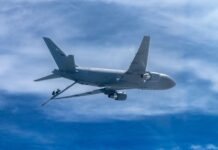Boeing’s X-37B Orbital Test Vehicle (OTV) is preparing to launch for its eighth mission (OTV-8) from Florida’s Space Coast, Boeing announced on 28 July 2025.
Lift-off for OTV-8, which is scheduled for no earlier than 21 August at Boeing’s facility at Kennedy Space Center in Florida, comes less than six months after the successful completion of the OTV-7 mission, which was launched on 29 December 2023 and landed on 7 March 2025 after a mission duration of 434 days.
Since its inaugural launch in April 2010, the X-37B has spent more than 4,200 days in space.
OTV-8 will fly with a service module, expanding capacity for experiments and opening new opportunities for mission partners, which include the Air Force Research Laboratory and the US Department of Defense’s Defense Innovation Unit. The mission will host demonstrations of high-bandwidth inter-satellite laser communications technologies, as well as the highest performing quantum inertial sensor ever tested in space. The US Space Force will leverage insights from this mission to inform future space architectures.
“With each successive flight, the X-37B has demonstrated adaptability and flexibility by hosting diverse experiments and pioneering new orbital regimes,” Michelle Parker, vice president of Boeing Space Mission Systems, was quoted as saying in a company press release. “This mission continues that legacy by fielding cutting-edge technologies that advance our nation’s space capability and improve the resilience of future architectures.”
“OTV-8’s laser communications demonstration will mark an important step in the US Space Force’s ability to leverage commercial space networks as part of proliferated, diversified, and redundant space architectures,” stated US Space Force Chief of Space Operations General Chance Saltzman. “In so doing, it will strengthen the resilience, reliability, adaptability, and data transport speeds of our satellite communications architectures.”
The revolutionary quantum inertial sensor will demonstrate precise positioning, navigation and timing in a GPS-denied environment. Quantum inertial sensors, useful for navigation in deep and cis-lunar space, promise to push the technological frontiers of long-distance space travel and exploration.
“OTV 8’s quantum inertial sensor demonstration is a welcome step forward for the operational resilience of Guardians in space,” said Space Delta 9 Commander Colonel Ramsey Hom. “Whether navigating beyond Earth-based orbits in cis-lunar space or operating in GPS-denied environments, quantum inertial sensing allows for robust navigation capabilities where GPS navigation is not possible. Ultimately, this technology contributes significantly to our thrust within the Fifth Space Operations Squadron and across the Space Force, guaranteeing movement and manoeuvrability even in GPS-denied environments.”




![Heavy-lift rotorcraft: Where US hegemony meets the tyranny of distance The latest model of the Chinook, the CH-47F Block II, is expected to be in service into the 2060s, by which time successive models of the Chinook will have been in service for more than 100 years. [Boeing]](https://euro-sd.com/wp-content/uploads/2025/11/CH-47F-Block-II-Boeing-Kopie-218x150.jpg)


![Hypersonic weapon interceptor developments The US MDA plans to conduct Flight Test Aegis Weapon System-43 (FTM-43) with the goal of using an upgraded Standard Missile-6 (SM-6) to physically intercept an HTV-1 hypersonic target. [MDA]](https://euro-sd.com/wp-content/uploads/2025/09/SM-6-_-8314132-Kopie-218x150.jpg)




